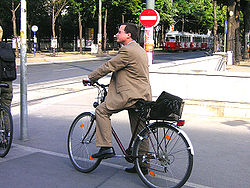
Mixed-mode commuting
Encyclopedia
Mixed-mode commuting refers to the practice of using two or more modes of transportation
. The goal of mixed-mode commuting is often to combine the strengths (and offset the weaknesses) of various transportation options.
, to which low-speed options are appended at the beginning or end of the journey. For example, commuters who live outside major cities often drive, pedal, or walk to a suburban train station. Trains offer quick transit into an urban area, where passengers can disembark and access a similar array of options to complete the trip.
s are conventionally used as a single-mode form of transit, they also find use in a variety of mixed-mode scenarios. They can provide a short commute to train stations, airports, and piers, where all-day "park and ride"
lots are often available. Used in this context, cars offer commuters the relative comfort of single-mode travel, while significantly reducing the financial and environmental costs.
Automobiles can also be used as the centerpiece of a multi-mode commute, with drivers resorting to walking or cycling to their final destination. Commuters to major cities take this route when driving is convenient, but parking options at the destination are not readily available.
 When a bicycle
When a bicycle
is used in place of a car, the cost and environmental benefits increase, but at the expense of comfort, security, and convenience. In warmer climates, and areas where cars are too expensive or otherwise impractical, bicycles provide an effective means of transport to and from a mass transit option.
In some cities, bicycles are permitted aboard trains and buses, allowing cyclists to ride at both ends of the commute. In recent years, folding bikes
have become an accepted option aboard mass transit systems that would otherwise prohibit the use of a bicycle.
Weather can also be a factor. Even when the use of an automobile is involved, the transition from one mode of transportation to another often exposes commuters to the elements. As a result, multi-mode commuters often travel prepared for inclement weather.
Mode of transport
Mode of transport is a term used to distinguish substantially different ways to perform transport. The most dominant modes of transport are aviation, land transport, which includes rail, road and off-road transport, and ship transport...
. The goal of mixed-mode commuting is often to combine the strengths (and offset the weaknesses) of various transportation options.
Mass transit
Mixed-mode commuting often centers on one type of rapid transitRapid transit
A rapid transit, underground, subway, elevated railway, metro or metropolitan railway system is an electric passenger railway in an urban area with a high capacity and frequency, and grade separation from other traffic. Rapid transit systems are typically located either in underground tunnels or on...
, to which low-speed options are appended at the beginning or end of the journey. For example, commuters who live outside major cities often drive, pedal, or walk to a suburban train station. Trains offer quick transit into an urban area, where passengers can disembark and access a similar array of options to complete the trip.
Automobiles
Although automobileAutomobile
An automobile, autocar, motor car or car is a wheeled motor vehicle used for transporting passengers, which also carries its own engine or motor...
s are conventionally used as a single-mode form of transit, they also find use in a variety of mixed-mode scenarios. They can provide a short commute to train stations, airports, and piers, where all-day "park and ride"
Park and ride
Park and ride facilities are car parks with connections to public transport that allow commuters and other people wishing to travel into city centres to leave their vehicles and transfer to a bus, rail system , or carpool for the rest of their trip...
lots are often available. Used in this context, cars offer commuters the relative comfort of single-mode travel, while significantly reducing the financial and environmental costs.
Automobiles can also be used as the centerpiece of a multi-mode commute, with drivers resorting to walking or cycling to their final destination. Commuters to major cities take this route when driving is convenient, but parking options at the destination are not readily available.
Bicycles

Bicycle
A bicycle, also known as a bike, pushbike or cycle, is a human-powered, pedal-driven, single-track vehicle, having two wheels attached to a frame, one behind the other. A person who rides a bicycle is called a cyclist, or bicyclist....
is used in place of a car, the cost and environmental benefits increase, but at the expense of comfort, security, and convenience. In warmer climates, and areas where cars are too expensive or otherwise impractical, bicycles provide an effective means of transport to and from a mass transit option.
In some cities, bicycles are permitted aboard trains and buses, allowing cyclists to ride at both ends of the commute. In recent years, folding bikes
Folding bicycle
A folding bicycle is a bicycle designed to fold into a compact form, facilitating transport and storage. When folded, the bikes can be more easily carried into buildings and workplaces or onto public transportation or more easily stored in compact living quarters or aboard a car, boat or plane...
have become an accepted option aboard mass transit systems that would otherwise prohibit the use of a bicycle.
Disadvantages
The effectiveness of a mixed-mode commute can be measured in many ways: speed to destination, convenience, security, environmental impact, and proximity to mass transit are all factors. Because mixed-mode commutes rely on a certain degree of coordination, scheduling issues with mass transit can often be an issue. For example, a sometimes-late train can be an annoyance, and an often-late train can make a commute impractical.Weather can also be a factor. Even when the use of an automobile is involved, the transition from one mode of transportation to another often exposes commuters to the elements. As a result, multi-mode commuters often travel prepared for inclement weather.

